Pruning flowering shrubs
What should you consider when you start planning your spring pruning tasks? Start by deciding what your main pruning objectives are, says Joel Kosa, an ISA certified arborist and owner of Boreal Tree Solutions.
General maintenance pruning typically includes pruning for the structure of your woody plant with the removal of deadwood and a bit of live growth, says Kosa. Other types of pruning might focus on the influence of flower or fruit production.
“Once you know what your objective is, it is important to determine what type of plant you want pruned and the variety that it is,” says Kosa.
“Some woody plants bloom on the current season of growth or previous season of growth. Some plants like hydrangeas have specific pruning requirements depending on their species.” Panicle hydrangeas for example, bloom on the current season of growth.
Bloom period is another factor. Spring blooming plants like forsythia or lilac should only be pruned once they have finished blooming. Summer blooming shrubs should be pruned in spring before they bloom.
“Being able to identify a woody shrub (species and variety) is crucial to determining when it should be pruned,” says Kosa.
“Generally, with woody shrubs that flower on current season’s growth, we prune as late in the season as we can, while a woody plant is still dormant in order to maintain flowers.
“We’ve had such a cold, cold winter. The weather needs to be consistently warm for a couple of weeks or even a month before pruning summer blooming shrubs that flower on the current season of growth.
“A few days of temperatures above zero is a great indicator that warm weather is coming, but for many types of woody plants the weather needs to be consistent for them to come out of dormancy.
“If a particular plant always blooms early or always blooms late, that is a guideline as well for when to prune. The client or homeowner always knows their property best,” says Kosa.
Flower farming doc
A new three-part Floret original documentary series, The Beautiful Pursuit, is now streaming on Floret’s YouTube channel.
Each episode is about 30 minutes long. The documentary includes more than 30 conversations with flower farmers from around the world.
The stories are engrossing and inspiring and the flowers and landscapes breathtaking to see.
Local seedlings
By all accounts, fresh produce at grocery stores is expected to cost more this year. By growing even just a small portion of your own veggies and herbs, you will be pleasantly surprised at how much you can save on your grocery bill.
Local garden centres are reporting a noticeable uptick in the sale of seed packets but starting plants from seeds is not convenient for everyone.
Purchasing seedlings that are ready for planting is quicker and easier. In no time you will be adding delicious flavours to your meals at a fraction of the cost.
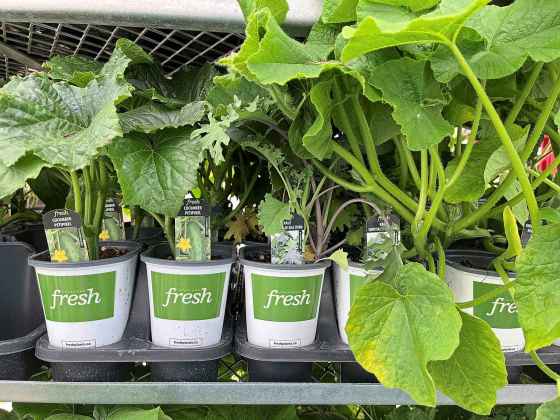
Grow your own with fresh brand veggie and herb seedlings, locally produced. (Vanstone Nurseries)
In 2015, Vanstone Nurseries in Portage la Prairie launched the Fresh collection of herbs and vegetables. Available at independent garden centres throughout southern Manitoba, the Fresh collection is produced and grown at Vanstone’s greenhouses.
All the varieties are GMO-free and grown without the use of pesticides. Many are compact and well-suited to growing in containers.
The collection has grown significantly since its launch a decade ago. Choose from numerous varieties of herbs, tomatoes, peppers, cucumbers, broccoli, cauliflower and more.
Two of the many new offerings from the Fresh collection this year include Konstance Kohlrabi, a 2025 AAS Winner, which has striking purple roots, stems and veins as well as Purple Magic Broccoli, the world’s first broccoli with purple stems and purple heads.
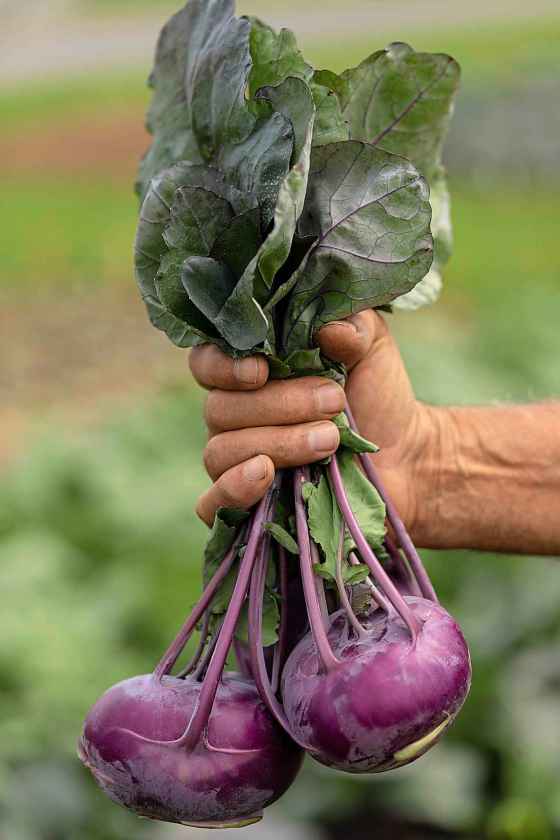
Vanstone Fresh, Konstance Kohlrabi, 2025 AAS Winner (All America Selections photo)
Purple Magic Broccoli is a 2024 AAS Winner. It is well adapted to growing in cooler seasons. Sweeter and more tender than green broccoli, enjoy it raw, stir-fried, roasted, lightly blanched or steamed.
Seedling tips
Most edibles prefer full sun but edible varieties that are tolerant of part-shade conditions include lettuce, cilantro, dill, Swiss chard, onion chives, mint, mustard greens and thyme.
A greenhouse plant should always be acclimatized gradually to outdoor conditions. Wait until there is no risk of frost before planting outside.
Create a beautiful small-space container garden with herbs for your patio, porch or balcony. Here are two edible container designs by Winnipeg gardeners:
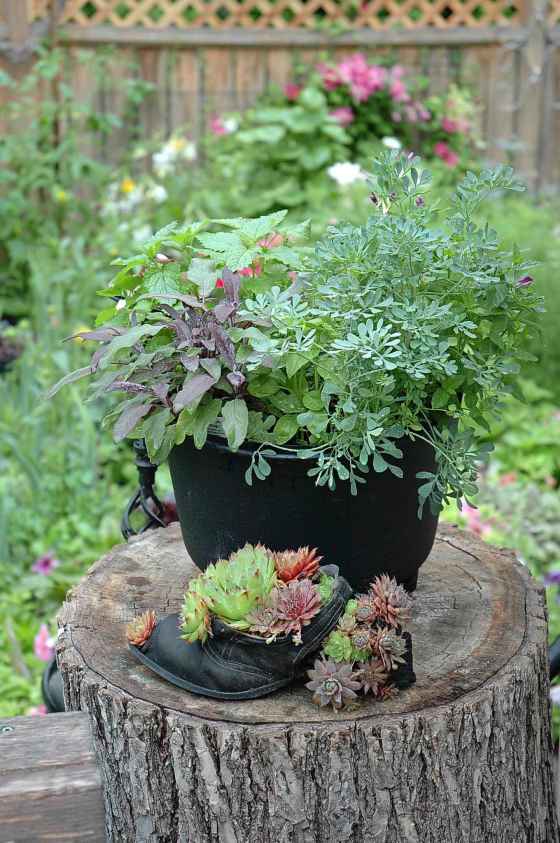
(Teresa Lopata photo)

(Debra Moore photo)
The Year of the Snake
In the Chinese Lunar New Year on Jan. 29, marked the beginning of the Year of the Snake.
Snakes are known to shed their skin and it just so happens that the snake plant has shed its botanical name and slithered over to a new plant family.
Previously known as Sansevieria trifasciata, the scientific name for snake plant is now Dracaena trifasciata.
Why the change? In 2017, scientist reclassified Sansevieria following molecular examination which showed that its DNA characteristics were more closely related to the Dracaena genus.
Interestingly, Dracaena is from the Greek word drakaina, a female dragon. Native to Nigeria, snake plant is also commonly known as mother-in-law’s tongue.
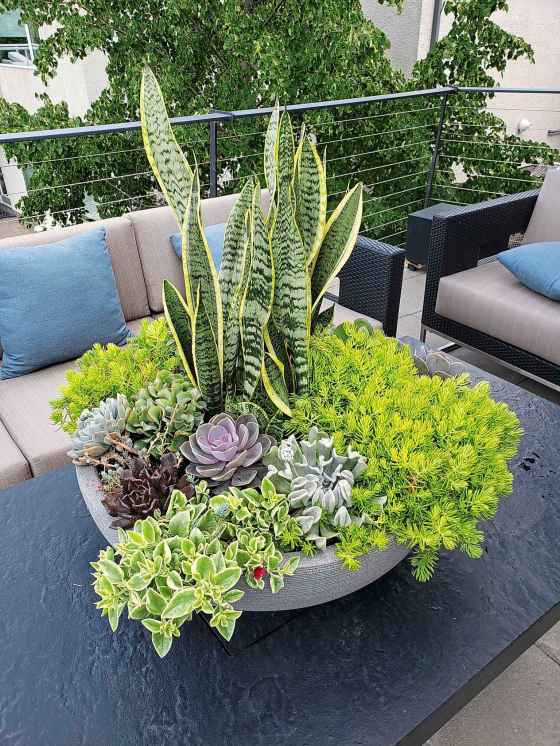
Snakeplant thriller in a container garden designed by Winnipeg’s Barefoot Gardener (Karen Chopp)
Family history aside, snake plant can be used to make a design statement in container gardens. I love the concept by Karen Chopp, a.k.a the Barefoot Gardener, to use snake plant as the thriller in a low-profile bowl, together with echeveria rosettes, trailing Mezoo, and sedum.
Marilyn Latta likes a snake plant of another kind. Fritillaria meleagris is a spring blooming bulbous perennial commonly known as snake’s head fritillary. There are white-flowered varieties as well as pinkish-purple and reddish-brown varieties with a fascinating checkered pattern.
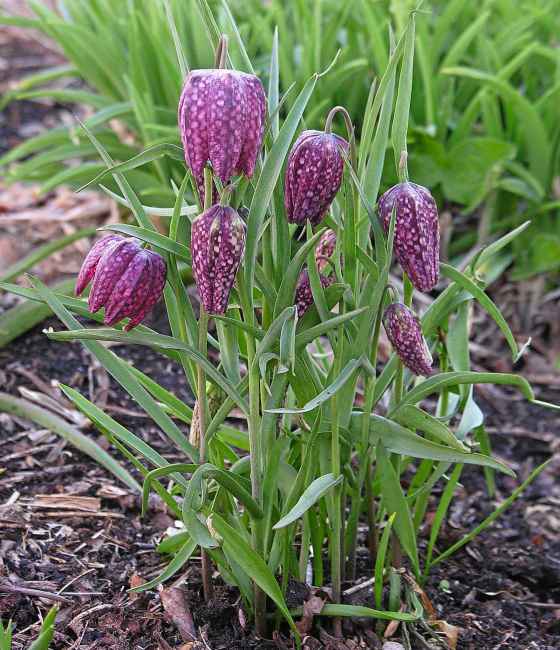
Snake’s head fritillaria with purple flowers (Marilyn Latta photo)
“The bulbs will self seed gently if the flowers are not deadheaded,” says Latta, who has grown snake’s head fritillary in her St. Vital garden for more than 30 years.
“Some of the seedlings reverted to a white colour form, which is not that unusual for pinky-purple plants.
“I like the purple ones planted close to the paths where I can get a close-up view of the beautiful patterns. However, I like the white ones where I see them from my kitchen window because they stand out in the landscape.
“From a distance, the purple ones tend to blend into the colour of the background soil and you don’t really notice them,” she says.
“Fritillaria meleagris is perfectly hardy and I have never noticed any dying off over the winter. They have bloomed in my garden as early as the last week of April but more typically they bloom around the middle of May.
“As with most spring bulbs, the bloom period is fairly short, maybe a week or 10 days depending on the weather.”
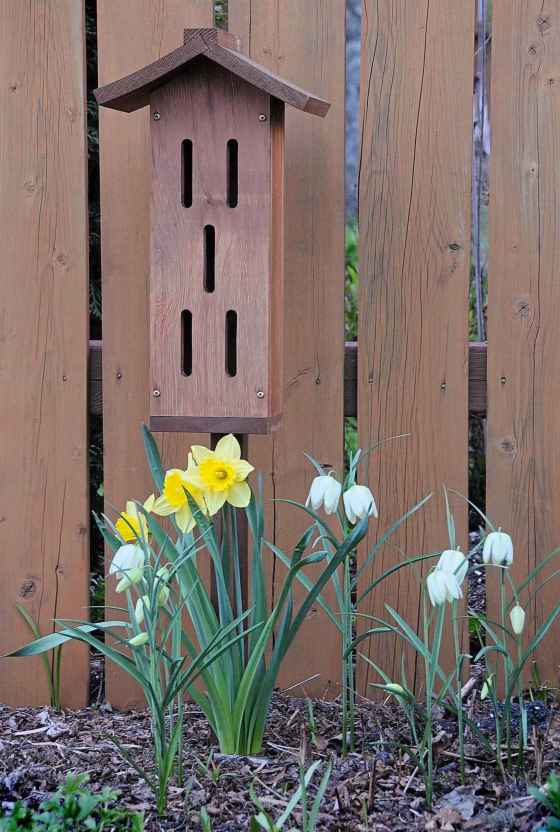
Snake’s head fritillaria with white flowers (Marilyn Latta photo)
The red lily beetle is known to feed on the leaves of fritillaria, but this hasn’t been a problem in Latta’s garden. “Because of the vertical position of the leaves and their small size, lily beetles would be easy to spot.”
Latta highly recommends the fritillaria. She says that visitors to her garden never fail to notice it or ask her about it.
“Fritillaria is very easy to look after. I usually give mine a shot of fertilizer once they have finished blooming. The foliage ripens quickly so once the plant has finished blooming, I cut off the flower heads.”
Buying Canadian
A new interactive website created by the University of British Columbia shows where 34 popular fruits and vegetables come from.
It’s an amazing tool for anyone who is interested in buying and supporting locally grown food — but it also highlights the challenges faced by Canadian consumers looking to shop local.
The site shows about half of vegetables and three-quarters of fruits consumed in Canada are imported.
The work aims to empower Canadian consumers to make more informed food choices and to consider sustainability issues such as the carbon footprint of food.
But another key takeaway must be that we explore ways to grow more types of food year-round in our cold climate, and ensure that we are growing the next generation of gardeners.
New flower stamps
On March 3, Canada Post launched this year’s annual flower stamp issue featuring beautiful peonies developed by Canadian-born horticulturists. The annual flower issue, says Canada Post, is a bestseller that is popular among brides and Canadian gardeners.
The featured peonies are Cytherea and Marie-Victorin. Cytherea was registered in 1953 by Arthur Percy (A.P.) Saunders, one of the most accomplished peony hybridizers of the 20th century. He was the son of William Saunders, who was the first director of Canada’s Central Experimental Farm.
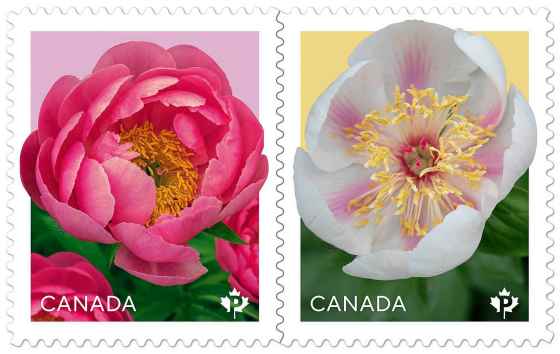
Annual stamps released March 3: Peony Cytherea (left) and Peony Marie-Victorin Peony. (Canada Post)
Cytherea, a semi-double herbaceous peony with deep rose-coloured petals, is named after the Greek goddess of love.
Marie-Victorin peony was named in honour of Frère Marie-Victorin (1885-1944), founder of the Montreal Botanical Garden. This pale pink peony with purple-pink flares was first propagated in 2004 by Lindsay D’Aoust, who purchased a collection of seedlings grown by Quebec peony breeder Maurice Menard.
Watch this YouTube video to see the beautiful colour of both peonies.
Tariff troubles
Speaking of tariffs (because who isn’t these days?), gardening industry association AmericanHort — in collaboration with industry associations that include the American Mushroom Institute, International Fresh Produce Association, National Association of Landscape Professionals and National Christmas Tree Association — is asking the U.S. government to exclude sphagnum peat moss and peat-based products from the tariffs applied to Canadian goods.
The sphagnum peat moss industry in North America is largely based in Canada, with 85 per cent of its production exported to the U.S. According to AmericanHort, this accounts for 96 per cent of American sphagnum peat moss imports.
The concern, says AmericanHort, is that a tariff on sphagnum peat moss would increase costs for American growers, resulting in higher prices for food products and greenhouse plants.
Garden centre news
• Shelmerdine Garden Centre on Roblin Boulevard in Headingley, has announced its acquisition by Chad Labbe and Matt Bell.
Labbe has served as vice-president and minority owner at Shelmerdine since 2010. Bell is the owner of Geller’s Design Build Landscape.
• Van der Meer Garden Centre in Île-des-Chênes is a family-run business owned by Len and Lori van der Meer. Their son Caleb now runs the wholesale and production side of the business. His wife Veronica manages the retail store. It’s all in the family! Preparations are underway for the centre’s 50th anniversary celebrations in 2026.
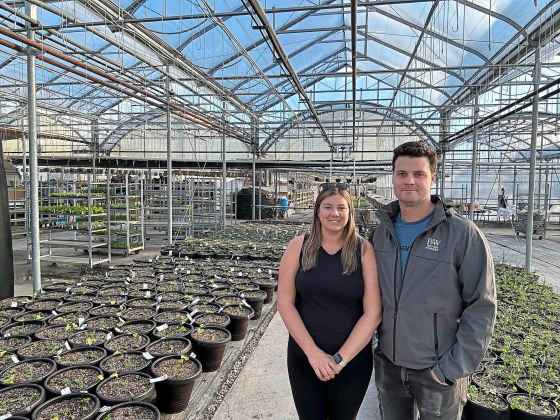
Veronica and Caleb van der Meer, next generation moving on up (Van der Meer Garden Centre)
• Alternative Choice Garden Centre is a family-owned and operated business in Brandon. In February, it was the recipient of MBNLA’s 2025 Garden Centre Award of Excellence at the Manitoba Nursery and Landscape Association’s annual green industry conference. Congratulations to owners Karin and Chris Griffin and all the staff!

Alternative Choice Garden Centre in Brandon, Winner of 2025 Garden Centre Award of Excellence (Alternative Landscape Ltd. photo)
• Oakridge Garden Centre is a family-owned greenhouse, café, boutique and flower bar located just outside of Steinbach. Owners Terry and Erna Wiebe are passing the torch to their daughter Megan Fontaine and her husband Pierre, who took over the operation on March 1.
“Pierre and Megan purchased our shares,” says Erna Wiebe. “They’ve been our partners for several years. Terry and I own the land and the building but (Pierre and Megan) have owned half the shares of the greenhouse operation. They purchased the rest of our shares so technically they are now my boss — I’ll be working for them!”
Wiebe worked at Oakridge Garden Centre for 11 years before buying it in 2000. What are her plans now? “2025 won’t look a whole lot different for me,” says Wiebe. “I’ll still be at the greenhouse a few days a week this spring and I plan to help out during the busy season at Christmas — but I will definitely take time off during the summer.”
A new delphinium
New for 2025, Delphinium Laser Beam features large (5 to 7 cm) dark purple florets on strong flower spikes.
Hardy to Zone 3, Laser Beam has a mature height of 60 to 76 cm. A rebloomer, the flowers sport a black bee centre.
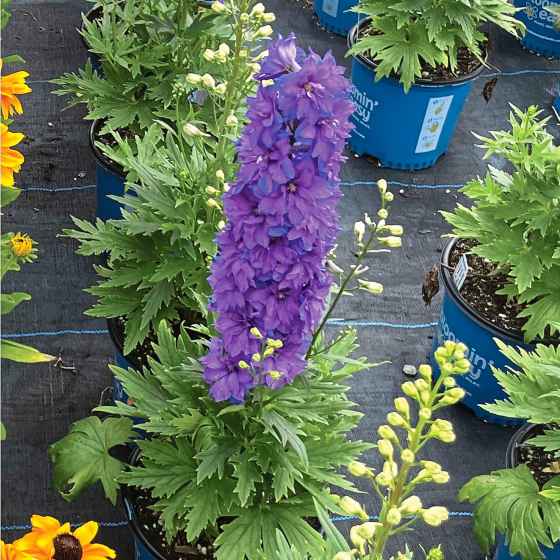
Delphinium Laser Beam, super sturdy stems, new for 2025 from Bloomin Easy (Bloomin Easy)
Interesting fact: the Bloomin’ Easy brand was launched in 2012 by Van Belle Nursery, a family-owned wholesale nursery located in Fraser Valley, B.C.
Aubin Nurseries in Carman is a propagator for Bloomin’ Easy plants. There are just a few degrees of separation between growers in Canada’s horticulture industry!
Elevate your designs
One of the easiest ways to make a statement in your garden is by displaying a container on a pedestal. Look at these two beautiful examples of containers planted with a mix of coleus.
In one example, John Tinkler created a picture-perfect scene in his south-Winnipeg garden last summer by setting a container of mixed coleus varieties with a dracaena spike on a planter and placing it next to a weathered cedar gate.
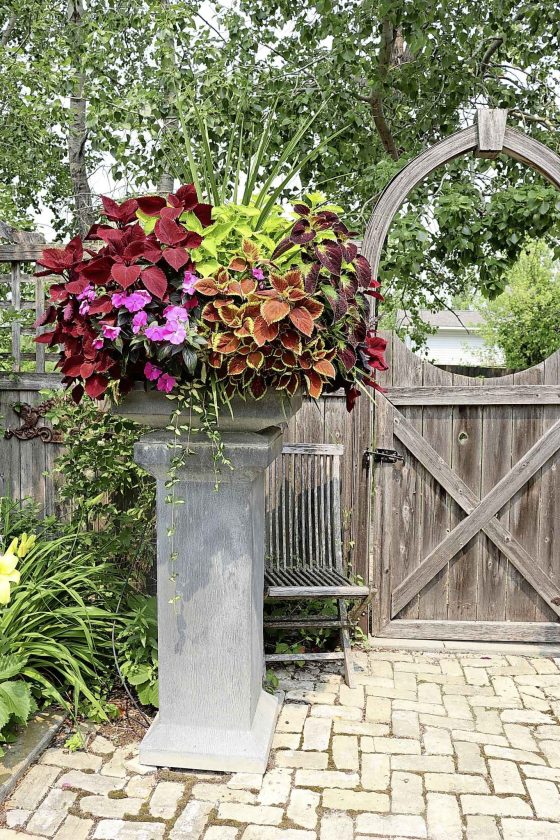
Create a scene: planter on pedestal, John Tinkler’s garden (Colleen Zacharias photo)
In another example, I stopped my car in a Headingley neighbourhood to take a photo of a vibrant coleus combo in deep purple and golden tones, with the added flourish of a variegated canna.
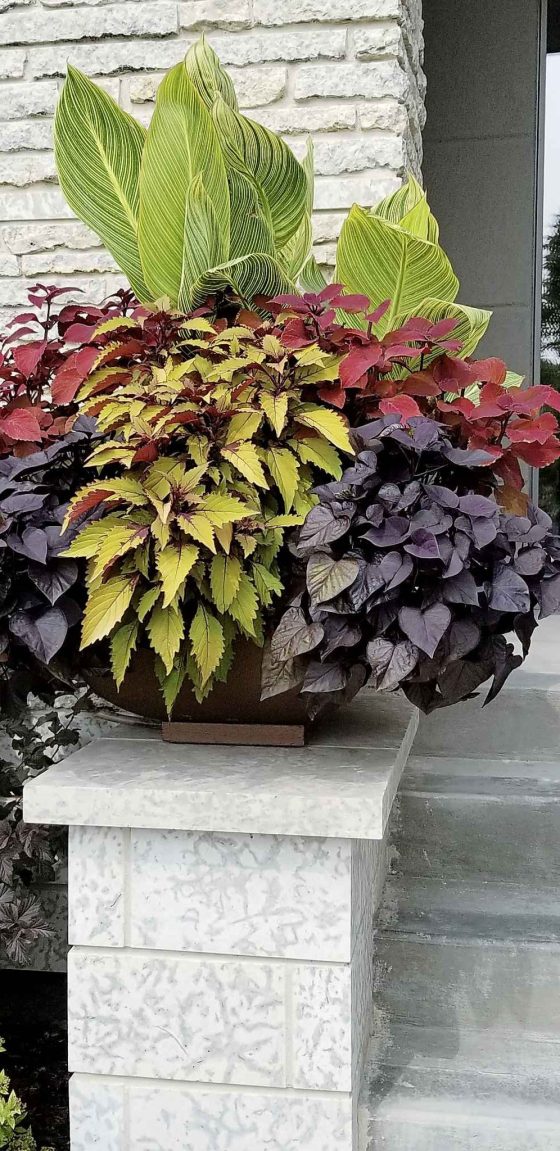
An elevated planter design: Headingley garden coleus and canna lily (Colleen Zacharias photo)
In both cases, elevating the containers enhances the overall impact. Let’s try this, too!
Propagating African violets
In last month’s edition of Winnipeg Gardener, Bonnie Batchelor, president of the Winnipeg African Violet Society shared tips on how to care for African violets. Here she discusses how to propagate African violets to make new plants and takes a look at new breeding that is on the horizon.
Propagating African violets is simple, says Batchelor. “Basically, it involves the same method that is used for propagating plants with fleshy leaves, such as sedums.”
Leaf petiole cuttings are the easiest method of propagation, says Batchelor.
“The bottom leaves are the oldest — I call them the old folks. The middle leaves are the teenagers and at the top of the plant, the tiny leaves at the growing point are the babies.
“To propagate, use the middle leaves. They are the healthiest because they have reached full size and are full of vigour, whereas the bottom leaves may be on the decline a little bit.”
Before removing any leaves, make sure your plant has been watered, which makes the leaves turgid — firm and full of water.
MAKING THE CUT
Start by taking a clean knife, cut the end of the stem at a 45-degree angle, making sure that the angle is on the front side of the leaf. That’s where the clump of new baby plants will grow once the stem has rooted, says Batchelor.
“Leaf removal is as easy as snapping off a leaf,” Batchelor says. “The traditional method is to place the leaf stem in a glass of water to root. I prefer to root the leaf in a rooting soil mix that is very fluffy — lots of perlite and lots of vermiculite.”
Batchelor says research has shown that the action of roots pushing against growing medium makes the roots stronger, compared to rooting a leaf stem in water.
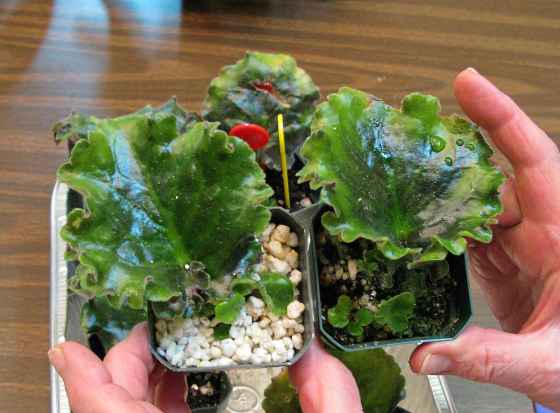
African Violet propagation soil mix with vermiculite or perlite (Susan Kotello)
“I like my baby plants to be a decent size before I start handling them,” says Batchelor. “Remove the plant from the rooting compound and separate the baby plantlets. Some will be a decent size and some will be little wee ones that have just started growing.
“Take off the biggest, healthiest ones and put the mother leaf with the baby leaves back into the rooting compound where they can grow bigger. It just depends on how many new plants that you want!”
GREENHOUSE EFFECT
To avoid transplant shock, it works best, says Batchelor, to create a mini greenhouse for your new potted leaf.
“One method is to place the potted leaf into a small food storage bag and zip it shut. A bread bag works, too. A store-bought clear plastic container that holds cookies or a cake works well so long as it is tall enough. Any of these methods will ensure adequate moisture and temperature levels for a couple of weeks.
“Then open or unseal whatever type of enclosure you are using and leave it slightly ajar. This helps your cutting to acclimatize to the humidity in your room. Maintain this for one week. Then remove the pot completely and your new plant is good to go.”
UNIQUE VARIETIES
African violets come in different size categories, says Batchelor. “Standard size is more than 20 cm across. Semi-miniature is 15 to 20 cm across and miniature is less than 15 cm across. All my plants are standards,” she says.
Batchelor’s collection includes intriguing varieties such as Kev’s Heavenly Star African violet, which has a star-shaped flower with a Geneva edge. “A Geneva edge is an edge colour that is different from the main leaf colour,” says Batchelor.
African violet Outerlimits has a pansy-shaped bloom with speckles on the bloom that are different than the main bloom colour.
Batchelor also grows Optimara Millennia, a standard which has dark red thumbprints. “It looks as though someone used their thumb to put dabs of colour on the blooms,” says Batchelor.
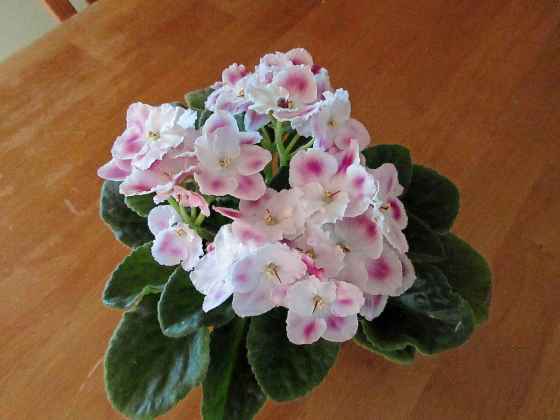
African Violet Optimara Millennia (Bonnie Batchelor)
Batchelor says that members of African violet societies will often grown registered plants which have been crossed by hybridizers with other varieties that have desirable traits.
“There aren’t many African violet hybridizers in Canada,” she says, “but there are quite a few in the U.S. Specialty African violets can be ordered from American suppliers, however a phytosanitary certificate is required to import plants into Canada. The cost is higher, too.”
African violet enthusiasts collect unique varieties that have variegated leaves or unusually shaped flowers.
New breeding is introducing violets that are filantherless, which means they do not have anthers and filaments. The benefit is that the plants will not attract thrips, a vector insect which can kill the plant if it spreads rapidly. “Thrips attack the pollen sacs on African violets,” says Batchelor.
A filantherless violet can be identified by the lack of a yellow centre on the flowers. “They have no pollen sacs,” says Batchelor, who notes she has not seen this variety in person.
Mark your calendars
Winnipeg Seedy Saturday takes place at the Millennium Library, 252 Donald St. (3rd floor), on March 8 from 10:30 a.m. to 3:30 p.m. This popular event will feature vendors, a seed swap, kids’ table, film screening, and skills sharing. Hosted by Spence Neighbourhood Association, City of Winnipeg and Seeds of Diversity. A program of events is available on Seedy Saturday’s Facebook page.
The Manitoba Orchid Society hosts its annual spring show and sale March 21 to 23 at the Breezy Bend Country Club, 7629 Roblin Blvd., in Headingley. Featuring rare and unusual orchid species, this year’s event includes daily orchid talks. Admission is $10. Full details on their website.
On Thursday, March 20, 7 p.m. to 9 p.m., the Manitoba Museum will host World Water Day 2025, a public lecture and Q&A session with Dr. C.J. Mundy and Dr. Tim Papkyriakou. Admission is $10. For full details and registration, visit Science First.
|

